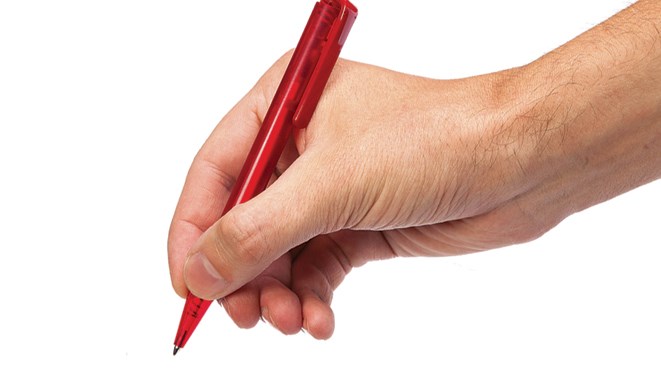By David Chirko
Graphology is the study of discerning personality through handwriting analysis.
A graphologist breaks handwriting down into constituent parts: style, legibility, slant, zones, basic line, pressure, speed/tempo, letter size, capitals, i-dots, t-bars, connections, numbers, regularity, signatures, margins, spacing and doodles.
The idea is pretty simple. By analyzing those metrics, a graphologist claims to be able to determine personality traits.
Some examples of this include heavy pressure put on a page reflects anger or frustration; letter size can obscure intentions and feelings over conflicts; the use of margins may illustrate how one interacts with time, people and convention; spacing can represent one’s acuity; tumultuous or messy scrawl could identify a mentally disordered miscreant.
As a pastime, I followed those indicators, seeking specific personality characteristics exhibited in handwriting samples I analyzed from unknown individuals, presented, sometimes, via my sister.
Sis would afterward peruse my analysis and, snapping her finger, exclaim, “That’s them, exactly!”
The graphologists and books I employed to analyze handwriting samples were Irene Marcuse, Ph.D., Guide To Personality Through Your Handwriting (1971); Stephen Kurdsen, Graphology The new Science (1971); and Andrea McNichol, B.A. with writer/producer Jeffrey A. Nelson, B.A. (English), Handwriting Analysis: Putting It to Work for You (1994).
In her book, McNichol proclaims she spent eight years researching graphology by seeking out psychiatrists who would be willing to partake in experiments to correlate handwriting characteristics to mental conditions.
Part of her research involved attempting to identify alcoholics from non-alcoholics based only on handwriting.
American psychologists, Fritz A. Fluckiger, Clarence A. Tripp and George H. Weinberg, in A Review Of Experimental Research in Graphology, 1933-1960 (1961), tell us their evidence shows “some personality traits can be successfully predicted from handwriting.” More specifically, they say graphology could show some personal interests, intelligence, neuroticism, anxiety level, impulsiveness, energy, and expressiveness.
Furthermore, the study authors say their findings regarding a graphologist’s ability to determine a person’s interests based on characteristics of handwriting also closely matched study subjects’ scores on the Allport-Vernon Study of Values Test.
Gordon W. Allport, Ph.D., was a world-renowned, totally scientifically oriented, American psychologist. The values test is a multiple choice questionnaire that purports to measure people’s values or beliefs.
In their review, Fluckiger, Tripp and Weinberg state a 1933 student had graphologists rate the handwriting of 50 people based on the characteristics measured by the Allport-Vernon Values Test.
“The ratings on aesthetic interest agreed unmistakably with … Allport-Vernon scores,” they wrote.
Nevertheless, graphology’s efficacy is challenged in 50 Great Myths of Popular Psychology (2010) by four psychology Ph.D. professors (three Americans and a Canadian): Scott O. Lilienfeld, Steven Jay Lynn, John Ruscio and Barry L. Beyerstein, respectively.
The last mentioned is an outspoken critic of graphology, who pursues McNichol at Quackwatch.com. (Note that none of the graphologists earlier adumbrated are alluded to in the Lilienfeld, et al, volume.)
The aforementioned authors concluded, “…Dean (1992) conducted…the most complete review of scientific tests of graphology. After performing a meta-analysis … over 200 studies, Dean found a … failure on the part of graphologists to detect personality traits or forecast work performance” (p. 178).
The authors referenced Dean’s review in “Does astrology need to be true?” from The Hundredth Monkey and other paradigms of the paranormal, K. Frazier, ed., pp. 279-319.
Geoffrey Dean, Ph.D., British-born Australian chemist and technical editor, is a former astrologer and his apparent lack of citation and flawed meta-analysis on astrology (how’d we get on this topic?) are contested at here.
The 50 Great Myths authors mention “The P.T. Barnum Effect,” regarding graphologist’s assessments of individuals, so vague it could apply to anyone. They endeavor to dispel the five most common reasons graphologists utilize to endorse themselves.
The big five are:
- Expressive movement. This, they say, can be demonstrated moderately through general kinesics, but not something as esoteric as handwriting. However, the mood of someone is often seen to affect their writing.
- Handwriting is tantamount to brainwriting. They contend that it’s the limbs more than the brain, as graphologists believe, which affect writing — just as sneezing. The sensorimotor response of the latter is nowhere near as complex as the various nuances of handwriting. Fatuous comparison.
- Writing and personality are individual, thus the synergy. The doubters compare this to the different faces on a driver’s license, which don’t tell whether or not a person is a good driver. Poor comparison again, as handwriting changes with circumstances, just as faces do.
- Jurisprudence employs graphology, making it widespread. They say confusion over this originates with QDEs — questioned document examiners, professionals that attempt to determine who penned a document. Yes, but all graphologists know that graphoanalysis is another facet of graphology.
- Corporations use graphology to hire the best people. They believe this is erroneous, because most don’t (that depends on country) as the bios contain other positive info graphologists get that causes them to recommend applicants; also, these candidates are already shortlisted and therefore preselected. That is veracious in maybe some scenarios (or more, according to American professor Richard Klimoski, Ph.D. [psychology & management]).
Finally, after balancing the pros and cons, above, I believe graphology still works in certain circumstances. At the very least, there is a modicum of scientific backing for some of it.
David Chirko is an abstract artist in Greater Sudbury. Do you have an idea for The Soapbox? Send it to [email protected].
